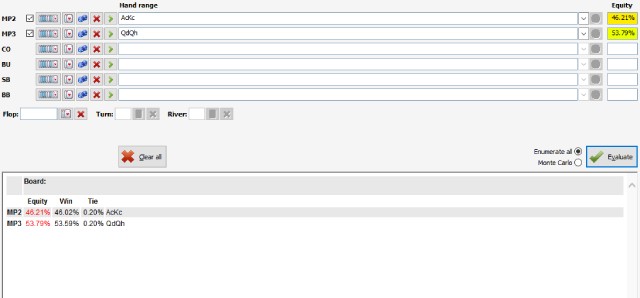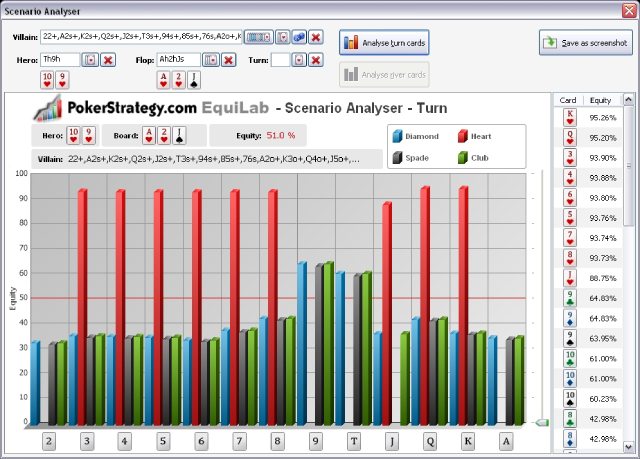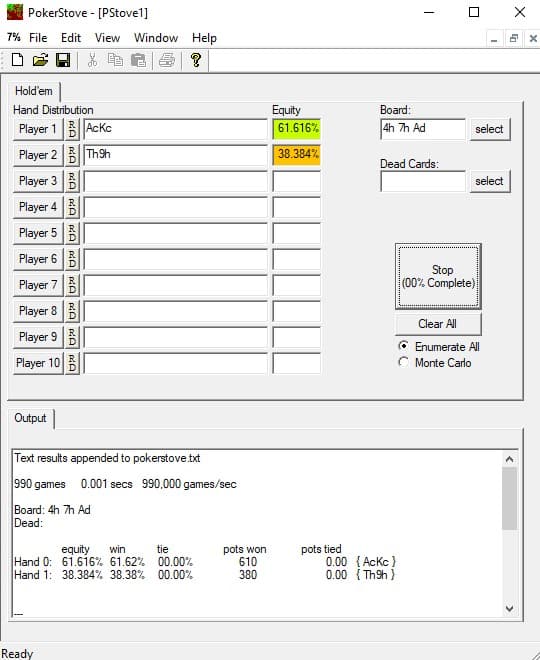Equity is one of the key terms in poker, and understanding its influence is essential to your game. We assume that most of our readers know what equity is, but just in case, here’s a quick reminder:
Equity is your “share” of the pot proportionate to your current chances of winning the hand. Let’s refer to a typical example: if you go all-in with AK of clubs and get called by red queens, you will win roughly 46% of the time. Subsequently, it means that if you and your opponent put $100 each into the pot, on average, you will get $92 (46% of $200 – we’re skipping the rake factor for simplicity).
How do you know how much equity you have?
There are three most common ways equity is expressed. The first and the most basic one is mentioned in the example above. It’s called hand versus hand equity. Like in the AK example, it describes how much equity a particular hand has against any other hand.
If you are an experienced player, you should be able to identify how most starting hands fare against each other quickly. If you are a newer player, don’t worry – after some time and practice, you’ll memorize how much equity specific holdings have.
The second way of expressing equity is called hand versus range equity. While the idea is simple, estimating this kind of equity requires deeper knowledge and experience. An example of hand vs. range equity is 84.83% for AA against a wide button open range (50% of all poker hands).
The last equity type is range versus range equity. It’s definitely the hardest kind of equity to estimate, as both ranges can consist of dozens of hands. It’s almost impossible for a human to memorize the equities of all the possible ranges versus other ranges. However, with some practice, you can become quite accurate in the most common estimations.
Keep in mind that all of the above equity calculations can be done for preflop and any postflop board combinations (flop, turn or river). In the latter case, the degree of difficulty in estimating the equity increases.
Fear not, though, as there is a powerful ally to help you with your struggles.

Poker tools will help you a ton in estimations
We’ve already covered the topic of poker tools and software – here, you can read more about the best poker apps on the market.
Alongside tracking software and ICM tools, the poker equity calculator is one of the most useful poker programs you can work with. It will quickly calculate poker equity for almost any reasonable scenario.
A poker equity calculator is invaluable in day-to-day study
It will provide you with exact equity for any hand or range versus any other hand or range on any given board. It’s a great tool to develop your poker knowledge and intuition – it helps you visualize how equity changes in different circumstances.
For example, you open AK UTG in a 100BB cash game, get called by a big blind, and the board is AT2 rainbow. How much equity do you approximately have against the opponent’s range? How would your equity change if we didn’t change the ranges, but the board would run 988 with a flush draw? The poker equity calculator will quickly answer that, as well as many other questions.
There’s no doubt in our minds that such a calculator is a must for every poker player. Luckily, there are many different tools on the market, and the most popular – PokerStrategy Equilab – is free to download. If you’ve never used any poker tool, Equilab is a great place to start.
Important disclaimer: poker equity calculators, along with a few other tools, are so powerful and useful that they are prohibited during play. Use them only outside the poker table, otherwise you might be banned by the poker room you play on.

Okay, but why is it so important in poker?
The simple answer is that it allows you to estimate whether you should put more money into the pot or not based on the pot odds you have.
Let’s back it up with an example: you are playing a live cash game and face an all-in bet of $100 in the $100 pot. You’re holding an ATo, and the board is T98 rainbow. Your pot odds are 2:1, which means that you need more than 33% equity for a call to win you money (or, in other words, you need to win more than one out of three times to profit).
If your opponent is a loose player who’s willing to go all-in with any pair, straight draw or a gutshot, you’re very likely to have more than 50% equity, thus it would be a very profitable call.
If, on the other hand, you are playing against someone very tight who is willing to risk all of their chips only with nutted hands (like two pairs or better), it’s possible that your equity is closer to 20%, and you will be better off folding.
It’s a big simplification, but that’s a baseline scenario to apply your knowledge about equity. Of course, there will be a lot of situations where the bet you face won’t be an all-in (so you’ll have to consider action on the future streets and your implied odds) or you will have a hard time pinpointing the entire range of your opponent, so the math won’t be that straightforward. Despite the circumstances, estimating your equity in hand is always the core of any viable poker strategy.
If you would like to calculate equity more efficiently, find out more about optimal strategies, and become a part of the great poker community, check out our offer – now you can try what Smart Spin has to offer for free for 30 days!

Remember equity realization
It’s worth stressing that the equity numbers are accurate only when the hand reaches showdown. So, if you and your opponent go all-in at any point in hand, over a large sample size, you both will win, on average, chips corresponding to the equity you had when all the money went to the pot. In other words, if any player folds before the showdown is reached, they won’t be able to realize their equity.
Why is that important? Because sometimes it will be difficult to realize your equity in practice. Let’s look at another example: let’s assume you defended a big blind against a wide open from a button (50% of hands) in a 100BB cash game. The board runs out Ad6c2d.
In the first scenario, you have 32 of hearts. A quick look in an equity calculator shows that you should have around 50% equity against a wide button opening range. A decent spot to be in, right? Not necessarily. You have to consider that it will be difficult to realize your equity. A weak pair with no kicker will have a hard time calling subsequent bets on almost every turn and river (barring those improving you to the two pairs or a trips).
In the second scenario, you have 75 of diamonds. While it is only a seven high, it has way better equity realization – quite often, you hit a flush, and you can hit a seven for a second pair or an eight or a four to improve to the open-ended straight draw.
In the abstract sense, your hand in the second scenario is worse, but in practice, it will be much easier to play and, as a result, to realize its equity.
There’s more to learn about poker equity
But we’d like to keep it simple in this article, as we know that it takes time to digest the mathematical aspects of poker.
If you’d like to dive deeper and learn about equity distribution and other advanced poker concepts, join Smart Spin. For years, our coaches have been providing the best poker strategies and support. Our players make a great community, and you can become part of it.
Try it out for yourself, now 30 days free of charge.
